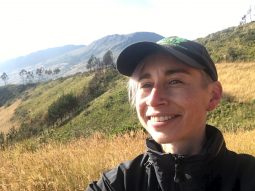Virginia Toy

2016: Dr Virginia Toy, University of Otago, Department of Geology, has been awarded a Rutherford Discovery Fellowship for research entitled: 'Weaving the Earth’s Weak Seams: Manifestations and mechanical consequences of rock fabric evolution in active faults and shear zones'.
Biography
Dr Virginia Toy is a Senior Lecturer in Geology at the University of Otago. She obtained her PhD from the University of Otago, after which she undertook a postdoctoral position at the University of Wisconsin-Madison and Texas A&M University, USA. She has been a visiting researcher and lecturer at a number of international Institutions, most notably the University of Liverpool (UK), GFZ-Potsdam (Germany), Hokkaido University (Japan), and Yachay Tech University (Ecuador). She is involved globally in research initiatives in the fields of structural geology, tectonics, geohazards and geoengineering – employing a multi-scale observational approach, validated by experiments and numerical models, to understanding the physical behaviours of Earth Materials. She is recognised internationally for her involvement in Continental and Oceanic Scientific Drilling of active fault systems.
Research summary
Fault zone rocks, particularly those that delineate tectonic plate boundaries, have distinct structural fabrics and mineralogy that give them unique mechanical properties. They form through multiple cycles of shearing, and alteration caused by fluid-rock interactions. The unique mechanical properties affect the rate and amount of slip faults accommodate during earthquakes – determining whether a particular fault will slip in a ‘slow slip’ event which causes no damage, or generate a huge and damaging quake. Fault rocks’ structural fabrics also influence movement of fluids within the Earth, affecting geothermal circulation and mineral deposition. Finally, they result in unique geophysical signatures that are extensively employed in mineral exploration targeting.
Fault and ductile shear zone rocks can be revealed at Earth’s surface due to uplift; this is the case in New Zealand’s Alpine Fault zone, where exposed rocks are frozen equivalents of those presently deforming at depths of up to 35km. Drilling into active faults such as this, and collecting samples from the drilled hole(s) provides an opportunity to analyse changes in structural fabrics and mineralogy of the fault zone rocks as they are progressively bought to the surface. In this project, Dr Toy proposes to use new electron microscopic methods to analyse the very fine structure of fault rocks from outcrops, scientific boreholes, and experiments. In addition, she will use innovative high pressure-temperature rock deformation apparatuses and computational modelling to measure geophysical properties and simulate deformation processes in order to unravel some of the complex factors that result in the formation of unique fault zone rocks.
